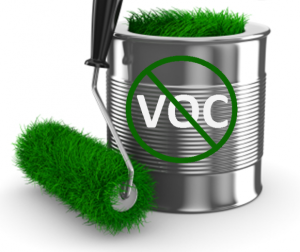Anyone who’s painted a room, or walked into a freshly painted one, knows that distinct “new paint smell.” But most people don’t know that most of what they’re smelling are volatile organic compounds (VOCs for short) and that those compounds are potentially harmful to your health.

The “V” in VOC stands for “volatile” and in this sense means that these chemicals evaporate or can easily get into the air at room temperature. VOCs can be found in many products used in manufacturing, furnishings, and other products common in homes. Paint and protective coatings are a major source of VOCs. Approximately 12 billion litres of paints are produced annually.
The reason why VOCs are found in paint is because they provide certain desirable working qualities, like spreadability and improved durability. Minimal exposure to these chemicals, such as painting one room of your home, may cause temporary health issues like headaches, dizziness or nausea. People who come in contact with VOCs on a regular basis, such as auto spray booth operators, or people who have prolonged exposure times can experience damage to the kidneys, liver, and nervous or respiratory systems.
Motivated by cost, environmental concerns, and regulation, the paint and coating industries are increasingly shifting toward water-based solvents which are referred to as low-VOC or no-VOC paint. When using one of these options, the lack of “paint smell” is very noticeable. Due to pressure by consumers and regulators, many of these alternative paints are priced the same as their VOC containing counterparts.
When choosing a paint, it is best to go with a latex option, as latex uses fewer chemicals than the other common type of paint, alkyds. If you chose a low- or no-VOC latex paint, you will probably notice the faster drying time. No matter what type of paint you work with, always open a window or door (after the paint has dried if it is humid or raining out) to allow any lingering smell or chemicals to dissipate.

